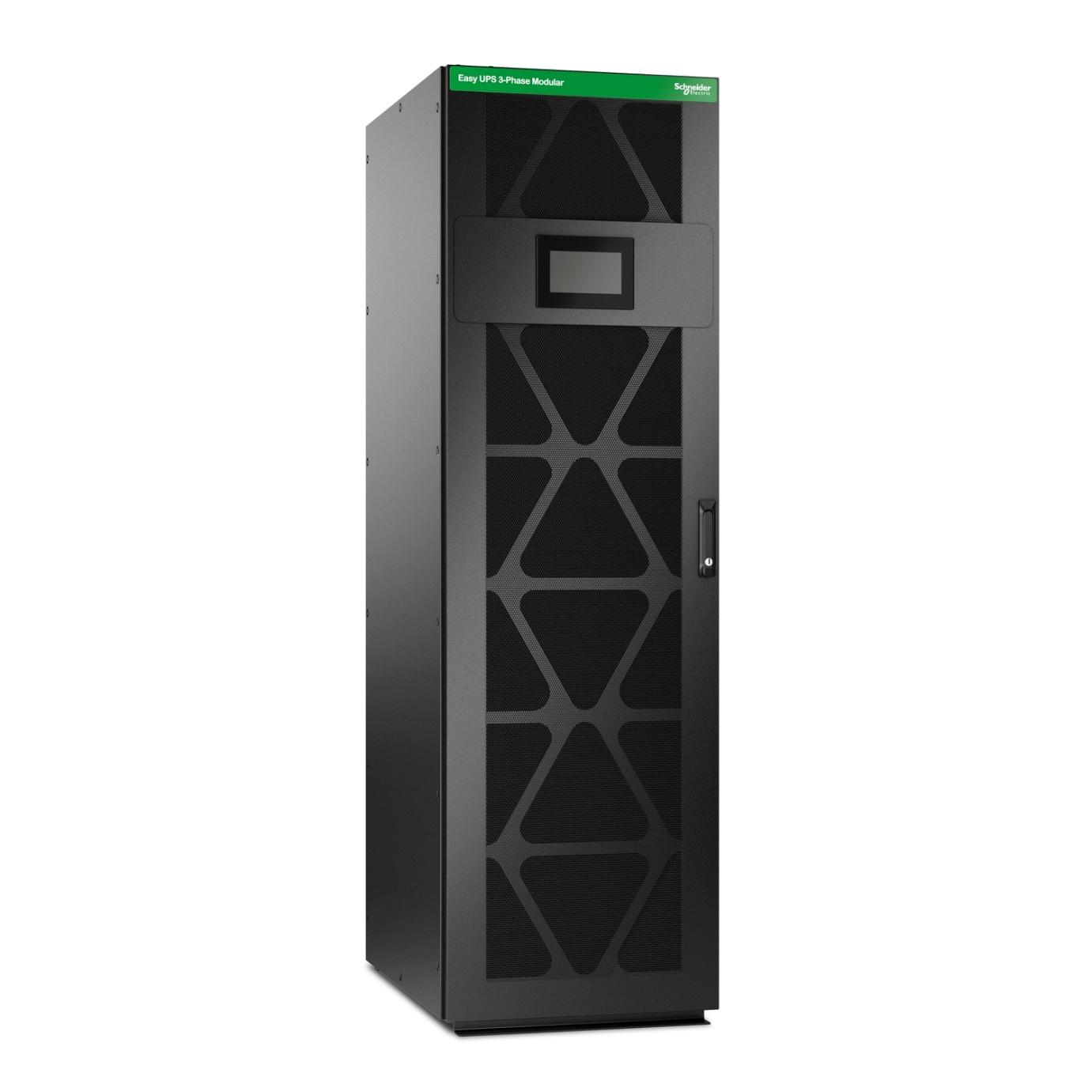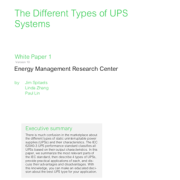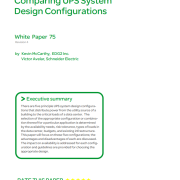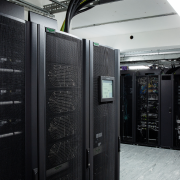What To Do With An Older UPS WhitePaper
In the dynamic landscape of data centre management, the decision of when to replace an ageing Uninterruptible Power Supply (UPS) system is a critical one. Addressing this concern is not a one-size-fits-all scenario; it demands a nuanced approach, taking into account various factors unique to each data centre. At Advanced Power Technology, we recognise the importance of making informed decisions that align with your specific circumstances and requirements.
To guide data centre owners and managers through this decision-making process, we’re sharing the comprehensive whitepaper by Schneider Electric. Titled “Guidance on What To Do with an Older UPS”, this whitepaper provides a straightforward framework to help you answer the pivotal question of when an older UPS should be replaced with a new one.

Understanding the Options
The whitepaper delves into three primary options:
- Run to Fail: Explore the implications and considerations of allowing your UPS to run until a failure occurs.
- Upgrade: Understand the possibilities and advantages of upgrading your existing UPS system.
- Buy New: Delve into the factors influencing the decision to invest in a completely new UPS system.
Why This Matters
In a world where data centre operations are constantly evolving, making the right choices for your infrastructure is crucial. The whitepaper empowers you with insights to navigate through the complexities of UPS management, ensuring the reliability and efficiency of your data centre.
How to Access the Whitepaper
To gain a deeper understanding of these options and make informed decisions about your UPS strategy, we invite you to download the full whitepaper from Schneider Electric. Simply Download on the form below to unlock a wealth of information that can shape the future of your data centre.
Guidance on What to Do with an Older UPS Whitepaper Download
Download Guidance on What to Do with an Older UPS Whitepaper from Scheinder.
At Advanced Power Technology, we are committed to providing you with the knowledge and tools needed to optimise your data centre’s performance. Explore the possibilities, make informed choices, and take the next step towards a more resilient and efficient UPS strategy.
The Easy UPS 3-Phase for Schneider
The New Easy UPS 3-Phase Modular UPS is a scalable, easy-to-deploy 3-phase uninterruptible power supply with a compact footprint that optimises capital investment for small and medium data centres and other business-critical applications. This UPS is EcoStruxure™ connected to give you peace of mind anytime, anywhere.
-
- Optimise your capital investment with the pay-as-you-grow scalable design
- Boost your availability with N+1 redundancy options
- Expand capacity fast with no scheduled downtime, with third-party verified Live Swap of power modules
- Conserve valuable real estate in style, with up to 250 kW N+1 of power protection in a sleek black one-rack design
- This UPS is EcoStruxure™ connected to give you peace of mind anytime, anywhere. Start-up service is included to optimise your system’s performance, quality, and safety.
What are the benefits of Modular UPS?
Modular uninterruptible power supply (UPS) systems offer several advantages compared to traditional, non-modular UPS solutions. The below overview will highlight the benefits.
UPS Scalability:
One of the main advantages of modular UPS is scalability. Modular systems allow you to add or remove power modules based on your changing power requirements. A modular design enables you to scale your power protection infrastructure easily as your business grows or as power needs change.
Increased Availability and Reliability:
Modular UPS systems typically feature a redundant or N+1 architecture, meaning that if one module fails, the others continue to support the load without interruption. This design improves system reliability and availability, reducing the risk of downtime due to a single point of failure.
Ease of Maintenance:
Modular UPS systems are designed for easy maintenance. In the event of a failure, it is often possible to replace or service individual modules without shutting down the entire system. This results in lower maintenance costs and reduced downtime during repairs.
Efficiency:
As it is more efficient to run a UPS closer to its design load, modular UPS systems can be more energy-efficient than traditional UPS systems during periods of low load. Some modular designs allow for power modules to be turned off when not needed, increasing overall efficiency and reducing energy consumption.
Flexibility in Configuration:
Modular UPS systems offer flexibility in terms of configuration. You can configure the system to meet specific power capacity requirements, and you have the option to mix and match modules based on your needs. This adaptability is particularly beneficial in dynamic IT environments.
Modular UPS Cost Savings:
While the initial upfront cost of a modular UPS system may be slightly higher than that of a traditional UPS, the scalability and efficiency of modular systems can lead to cost savings over time. As your power requirements evolve, you can expand your system without having to replace the entire UPS infrastructure.
Hot-Swappable Components:
Many modular UPS systems feature hot-swappable components, including the inverter/rectifier static swich and intelligence modules, allowing you to replace or upgrade modules without shutting down the entire system. This capability contributes to increased uptime and operational continuity.
Parallel Redundancy:
Modular UPS systems often support parallel redundancy, meaning multiple UPS modules can work together to share the load. If one module fails, the others can compensate, providing a higher level of redundancy and ensuring continuous power supply.
It’s important to note that the specific benefits of a modular UPS system can vary depending on the design and implementation of the system, so it’s advisable to carefully consider your specific requirements and consult with experts in the field when choosing a UPS solution for your needs.
Breaking Down What is in a Data Centre?
A data centre is a specialised facility specifically designed to house and manage critical computing equipment and infrastructure essential for the storage, processing, and distribution of digital data and services.
All of this equates to keeping your business or organisation up and running from a digital perspective.
Ever tried to work when you can’t send emails? Or finish off a team project you can’t access your network drive? It’s extremely frustrating, and can actually cost your business money.
The long and short of it is that, without a high-performing, well-designed data centre for your business, your daily operations could realistically grind to a halt.
So, with that in mind, it’s important to understand what a data centre is, and how it supports your business.
The main elements of a data centre are outlined below:
What’s in a Data Centre?
Servers and Computing Equipment
Data centres contain IT racks or cabinets filled with servers, which are powerful computers that run applications, process data, and serve information to users. These servers can include web servers, database servers, application servers, and more.
Networking Infrastructure
Data centres have a complex network of routers, switches, and cables to ensure that data flows efficiently between servers and to external networks like the internet. This infrastructure enables communication between various components within the data centre and connects the data centre to the outside world.
Storage Systems
Large data centres have extensive storage systems, such as hard drives, solid-state drives, and network-attached storage (NAS) devices, to store vast amounts of data, files, and databases.
The Physical infrastructure required to support your IT Equipment
In addition to understanding what a data centre does for your business, it’s crucial you also have an idea of the physical requirements to building and maintaining a data centre. If you’re ever facing any server downtime, it’s highly likely it’s the physical elements that are facing issues.
Let’s take a look at the physical infrastructure needed to design, build and maintain a data centre.
Cooling Systems
Data centres generate a significant amount of heat due to the operation of servers and networking equipment. Around 98% of the power that enters a data centre, is turned into low grade heat. Cooling systems, including air conditioning and precision cooling units, are crucial to maintaining the optimal temperature and humidity levels to prevent overheating and equipment failure.
Constant Supply of Power
Data centres require a stable and reliable power supply to ensure uninterrupted day-to-day operations. They have backup power sources, such as uninterruptible power supplies (UPS) and generators, to safeguard against power outages. The UPS is specifically designed to kick in in the event of a power failure and bridges the gap between power loss, and a generator starting. Generators then support the load for longer outages until the grid power returns.
Security
Security measures are critical to protect the data centre’s physical and digital assets. Access control systems, surveillance cameras, biometric scanners, and security personnel are commonly employed to safeguard the facility.
Redundancy
To ensure high availability and minimise downtime, data centres incorporate redundancy in various elements. This redundancy includes duplicate servers, network connections, power sources, and cooling systems. If one component fails, another takes over to keep services running. There are various levels of redundancy, including N+1, where you have the hardware to meet your capacity + one extra system that takes the strain if one hardware element is out of service. 2N involves doubling the quantity of hardware above what it needed for normal operation.
Fire Suppression
Data centres deploy specialised fire suppression systems that can extinguish fires without causing damage to sensitive equipment. These systems often expel the oxygen from the data centre so the fire can not propagate.
Monitoring and Management Software
Sophisticated software is used to monitor the health and performance of all data centre components. This software alerts operators to issues and helps manage resources efficiently.
Environmental Controls
Data centres control factors like temperature, humidity, dust, and contaminants to create an optimal environment for sensitive equipment.
A data centre is a highly controlled and secure facility that brings together computing hardware, networking infrastructure, cooling, power, and other critical components to ensure the reliable and efficient operation of digital services and data storage for businesses and organisations.
Designing and building data centres that perform well, with minimal downtime or disruption takes into account all of the elements above. As such, expertise and experience is crucial when creating a data centre that delivers the needs of your individual business or organisation.
Here at Advanced Power Technologies, we’re experts in doing just that. Get in touch to find out more about creating or improving your data centre.













